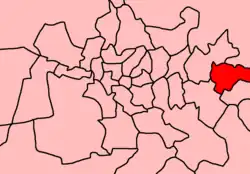Benoni (House of Assembly of South Africa constituency)
| Benoni | |
|---|---|
| Former constituency for the South African House of Assembly | |
 Location of Benoni within the Witwatersrand (1981) | |
| Province | Transvaal |
| Electorate | 20,281 (1989) |
| Former constituency | |
| Created | 1915 |
| Abolished | 1994 |
| Number of members | 1 |
| Last MHA | J. J. Lemmer (NP) |
| Replaced by | Gauteng |
Benoni was a constituency in the Transvaal Province of South Africa, which existed from 1915 to 1994. It covered a part of the East Rand centred on the town of Benoni. Throughout its existence it elected one member to the House of Assembly and one to the Transvaal Provincial Council.
Franchise notes
When the Union of South Africa was formed in 1910, the electoral qualifications in use in each pre-existing colony were kept in place. In the Transvaal Colony, and its predecessor the South African Republic, the vote was restricted to white men, and as such, elections in the Transvaal Province were held on a whites-only franchise from the beginning. The franchise was also restricted by property and education qualifications until the 1933 general election, following the passage of the Women's Enfranchisement Act, 1930 and the Franchise Laws Amendment Act, 1931. From then on, the franchise was given to all white citizens aged 21 or over. Non-whites remained disenfranchised until the end of apartheid and the introduction of universal suffrage in 1994.[1]
History
The mines of the Witwatersrand were an early stronghold of South African trade unionism, and this made Benoni a safe seat for the Labour Party. Its first and longest-serving MP, Walter Madeley, was a cabinet minister in J. B. M. Hertzog's Nationalist-Labour pact government until he was fired for recognising the racially-integrated Industrial and Commercial Workers' Union. He then led the anti-Pact "National Council" faction, and was the undisputed leader of the party from 1933 until his death in 1947. By then, Labour were in an electoral pact with the United Party, who allowed them a free run in Benoni until 1958. In that year, after Labour leader Alex Hepple had broken the pact and begun to move the party in a more openly socialist and anti-apartheid direction, the UP fielded a candidate against them and won the seat.
From 1958 until 1977, Benoni was a fiercely-contested marginal seat, but the white working class was moving in a more conservative direction all across South Africa, and from 1977 onwards, the governing National Party were dominant. In the 1980s, the left-wing (Progressive/Democratic) and right-wing (Conservative) opposition parties were about equally strong in the constituency, allowing the NP to come through the middle by very safe margins.
Members
| Election | Member | Party | |
|---|---|---|---|
| 1915 | Walter Madeley | Labour | |
| 1920 | |||
| 1921 | |||
| 1924 | |||
| 1929 | |||
| 1933 | |||
| 1938 | |||
| 1943 | |||
| 1947 by | T. W. B. Osborn | ||
| 1948 | |||
| 1949 by | Leopold Lovell | ||
| 1953 | |||
| 1958 | D. G. Ross | United | |
| 1961 | |||
| 1966 | P. Z. J. van Vuuren | National | |
| 1970 | H. J. van Eck | United | |
| 1974 | |||
| 1977 | C. R. E. Rencken | National | |
| 1981 | |||
| 1987 | J. J. Lemmer | ||
| 1989 | |||
| 1994 | Constituency abolished | ||
Detailed results
Elections in the 1910s
| Party | Candidate | Votes | % | ±% | |
|---|---|---|---|---|---|
| Labour | Walter Madeley | 1,427 | 54.6 | New | |
| South African | G. M. Botha | 648 | 24.8 | New | |
| National | G. van N. Schonken | 539 | 20.6 | New | |
| Majority | 779 | 29.8 | N/A | ||
| Turnout | 2,614 | 77.3 | N/A | ||
| Labour win (new seat) | |||||
Elections in the 1920s
| Party | Candidate | Votes | % | ±% | |
|---|---|---|---|---|---|
| Labour | Walter Madeley | 1,114 | 51.2 | −3.4 | |
| National | H. P. Venter | 653 | 30.1 | +9.5 | |
| Unionist | George Rennie | 331 | 15.2 | New | |
| Independent | W. H. Andrews | 78 | 3.6 | New | |
| Majority | 461 | 21.1 | −8.7 | ||
| Turnout | 2,176 | 60.8 | −16.5 | ||
| Labour hold | Swing | -4.4 | |||
| Party | Candidate | Votes | % | ±% | |
|---|---|---|---|---|---|
| Labour | Walter Madeley | 1,233 | 63.1 | +11.9 | |
| National | H. P. Venter | 721 | 36.9 | +6.8 | |
| Majority | 512 | 26.2 | +5.1 | ||
| Turnout | 1,954 | 59.2 | −1.6 | ||
| Labour hold | Swing | +2.6 | |||
References
- ^ "EISA South Africa: Historical franchise arrangements". Eisa.org.za. Archived from the original on 9 May 2013. Retrieved 6 July 2012.
- ^ Schoeman, B.M. (1977). Parlementêre verkiesings in Suid-Afrika 1910-1976. Pretoria: Aktuele Publikasies.
- ^ Standard Encyclopaedia of Southern Africa (1972). "House of Assembly" (vol. 5, pp. 617–636). Cape Town: Nasionale Opvoedkundige Uitgewery (Nasou).
- ^ South Africa 1980/81: Official Yearbook of the Republic of South Africa. Johannesburg: Chris van Rensburg Publications.
- ^ South Africa 1983: Official Yearbook of the Republic of South Africa. Johannesburg: Chris van Rensburg Publications.
- ^ Government Gazette of South Africa, No. 10751. 22 May 1987. Pretoria: Government of South Africa.
- ^ Government Gazette of South Africa, No. 12109. 20 September 1989. Pretoria: Government of South Africa.